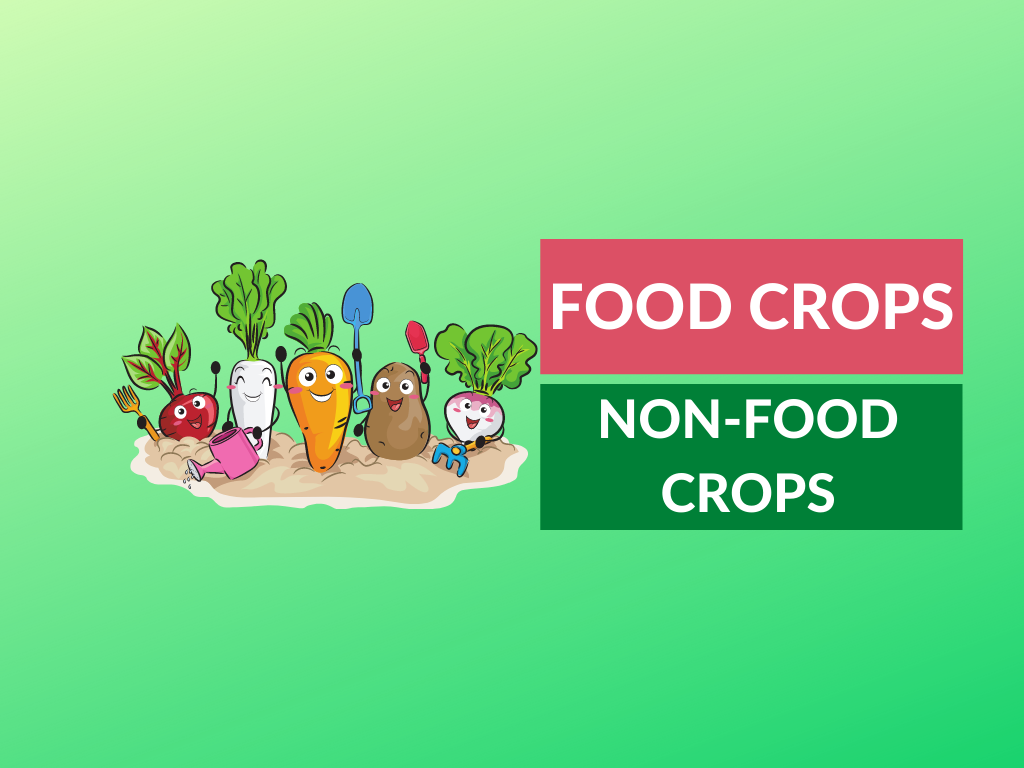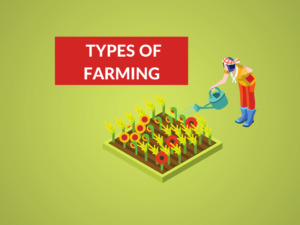In the general scenario, Food crops and Non-Food crops are related to agriculture. what is agriculture? what are Food crops and Non-food crops?
Agriculture is an age-old economic activity in our country. Over 58% of the population in India major source of livelihood is agriculture.
Over these years, cultivation methods have changed significantly depending upon characteristics of the physical environment, technological know-how and socio-cultural practices.
Meaning of Food crops and Non-food crops:
Food crops:
Food crops are crops that are grown solely for consumption purposes.
Example:
Sugarcane, oilseeds, tea, coffee etc;
Non-food crops:
Non-food crops are the crops that are used for profit rather than consumption. They are grown for commercial purposes.
Example:
Rubber, jute, cotton
Types of Food crops and Non-food crops:
Food crops
Sugarcane:
It is a tropical as well as subtropical crop. It grows well in hot and humid climates with the temperature of 21 degrees Celsius to 27 degrees Celsius and annual rainfall between 75 cm and 100cms irrigation is required in the regions of low rainfall. It can be grown on a variety of soils and needs manual labour from sowing to harvesting.
India is the second-largest producer of sugarcane only after Brazil. It is the main source of sugar, Gur (jaggery), Khandsari and molasses. The major sugarcane producing states are Uttar Pradesh, Maharashtra, Karnataka, Tamil Nadu, Andhra Pradesh, Telangana, Bihar, Punjab and Haryana
Oil seeds:
India is the largest producer of oilseeds in the world. Different oil seeds are grown covering approximately 12% of the total cropped area of the country. Most of these are edible and used as cooking mediums. However, some of these are also used as raw materials in the production of soap, cosmetics and ointments.
Tea:
Tea cultivation is an example of plantation agriculture. It is also an important beverage crop introduced in India initially by the British. Today, most of the tea plantations are owned by Indians. The tea plant grows well in tropical and subtropical climates endowed with Deep and fertile well-drained soil, rich in humus and organic matter.
Tea bushes require a warm and moist frost-free climate all through the year. Frequent showers are evenly distributed over the year and ensure the continuous growth of tender leaves. Tea is a labour-intensive industry. It requires abundant and skilled labour. Tea is processed within the tea garden to restore its freshness. Major tea-producing states are in the hill regions of Assam, West Bengal, Tamilnadu and Kerala. India is one of the leading producers as well as exporters of tea in the world.
Coffee:
India produces about 4% of the world’s coffee production. Indian coffee is known in the world for its good quality. The arabica variety initially brought from Yemen is produced in the country. This variety is in great demand all over the world. Initially, its cultivation was introduced on the Baba budan Hills and even today its cultivation is confined to Nilgiri in Karnataka, Kerala and Tamilnadu.
Horticulture crops:
India is one of the leading producers of fruits and vegetables in the world. Tropical and temperature fruits like mangoes of Maharashtra, Andhra Pradesh, Uttar Pradesh and West Bengal; oranges of Nagpur and Cherrapunjee(Meghalaya); bananas of Kerala, Mizoram, Maharashtra and Tamilnadu; litchi and guava of Uttar Pradesh and Bihar; pineapples of Meghalaya; grapes of Andhra Pradesh, Telangana and Maharashtra; apples, pear, apricots and walnuts of Jammu and Kashmir and Himachal Pradesh are in great demand the world ever.
India produces about ⅙ of the world’s vegetables. It is an important producer of a pea, cauliflower, onion, cabbage, tomato, brinjal and potato.
Non-food crops:
Rubber:
It is an equatorial crop, but under special conditions, it is also grown in tropical and subtropical areas. It requires a moist and humid climate with rainfall of more than 200 cm and a temperature above 25 degrees Celsius. Rubber is an important industrial raw material. It is mainly grown in Kerala, Tamil Nadu, Karnataka and Andaman and Nicobar Islands and Garo Hills of Meghalaya. India is among the world’s leading natural rubber producers
Fibre crops:
Cotton, jute, hemp and natural silk are the four major fibre crops grown in India. The first three are derived from the crops grown in the soil, the latter is obtained from cocoons of the silkworms fed on green leaves especially mulberry. The rearing of silkworms for the production of silk fibre is known as sericulture.
Cotton:
India is believed to be the original home of the cotton plant. cotton is one of the main raw materials for the cotton textile industry. India is the third-largest producer of cotton in the world.
Cotton grows well in dryer parts of the black cotton soil of the Deccan Plateau. It requires high temperature, light rainfall for irrigation, 210 frost-free days and bright sunshine for its growth. It is a Kharif crop and requires 6 to 8 months to mature. Major cotton-producing states are Maharashtra, Gujarat, Madhya Pradesh, Karnataka, Andhra Pradesh, Tamil Nadu, Punjab, Haryana and Uttar Pradesh.
Jute:
It is known as Golden fibre. Jute grows well on well-drained fertile soils in the floodplains where soils are renewed every year. A high temperature is required during the time of growth. West Bengal, Bihar, Assam, Odisha and Meghalaya on major jute producing states. It is used in making gunny bags, mats, carpets, ropes, yarn and other artefacts. Due to its high cost, it is losing market to synthetic fibres and packing materials, particularly nylon. However, in recent times the market is growing for eco-friendly jute.
Let’s summarize the similarities and differences between Food crops and Non-food crops
Difference Between Food crops and Non-food crops:
| Food crops | Non Food crops |
|---|---|
| Food crops are cultivated to provide food | Non-food crops are cultivated for commercial purpose. |
| These crops are grown solely for consumption | These crops are grown purely for commercialization. |
| These crops are essential but have less value when compared to non-food crops | These crops are cultivated for commercialisation and have more value. |
| Examples: sugarcane, tea, coffee, oilseeds etc; | Examples: rubber, jute, cotton, fibre crops etc; |
Bottom line:
So, when we compare the difference between Food crops and Non-food crops Farmers have been able to grow economically as a result of the availability of cash crops and food crops, reducing their reliance on government and international aid.
With the challenges that farming faces, risk-reduction strategies and adaptive techniques have been implemented. Farmers have also diversified cropping techniques in order to mitigate the risk of harvest failures.
Further related readings:



